By the late 1980s, Frank O. Gehry was very close to the moment of his consecration as a creator of landmarks capable of transforming the identities of entire cities, as well as becoming almost proverbial icons of entire eras and trends: the Guggenheim in Bilbao, with its titanium surfaces, is the most famous. But the moment Gehry won the competition for the new auditorium in Los Angeles is also the moment when all this was still about to happen, when the architect was still working to legitimize his position in both a Californian and an international context. His Walt Disney Concert Hall, the result of a 16-year process, has similar forms to the coeval Guggenheim, but opens up a profound discourse about concert space as a continuous and egalitarian space, and a discourse of connection to the city's public space, mediated by the very shapes of the new building in all their complexity.
Michael Webb told this story on Domus 863, in October 2003.
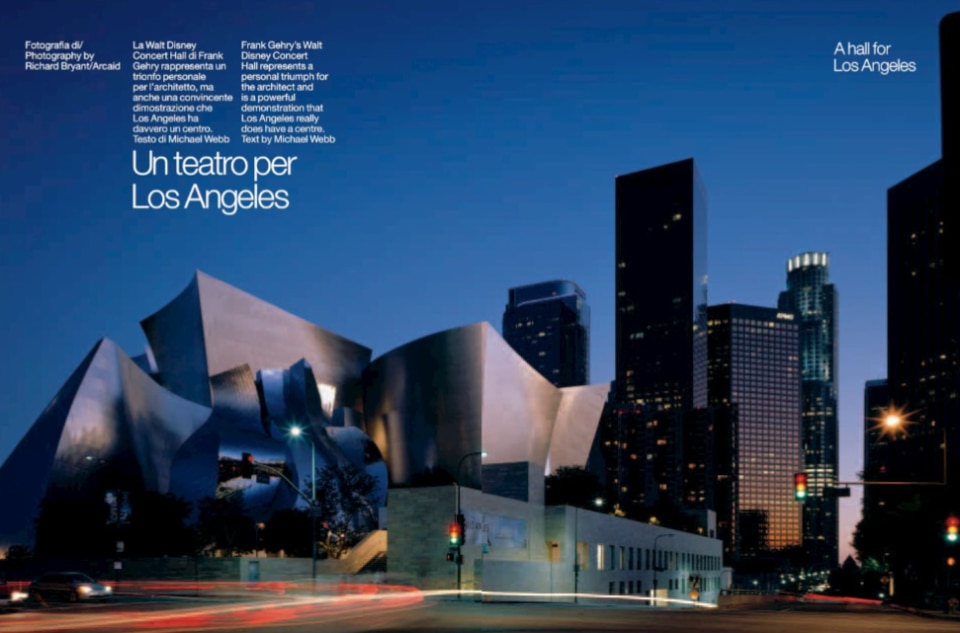
A hall for Los Angeles
The 16-year saga of Walt Disney Concert Hall parallels that of the Sydney Opera House – they even share the imagery of billowing sails. Both were the product of architectural competitions in which outsiders scored upset victories, and both designs were vilified by philistines, declared to be unaffordable and completed only after long and rancorous delays. All of this was forgotten when the opera house brought Sydney instant fame and a huge influx of visitors; Gehry’s shimmering icon is already helping to enhance the tawdry public image of Los Angeles, energize the city’s core and boost civic pride.
The differences are equally significant. Disney Hall was, from the start, a privately funded venture, born in May 1987 of Lillian Disney’s $50 million gift for a concert hall that would be a memorial to her late husband, Walt. In contrast to the Sydney Opera House, this was to be a single auditorium tailored to the needs of one client, the Los Angeles Philharmonic.
Frank Gehry won the commission with a well-thought-out scheme that was generated from the inside out, as opposed to Jørn Utzon’s form-driven concept. Gehry’s competition model articulated every major volume; the steel sails that wrap the completed building were the product of a radical redesign.
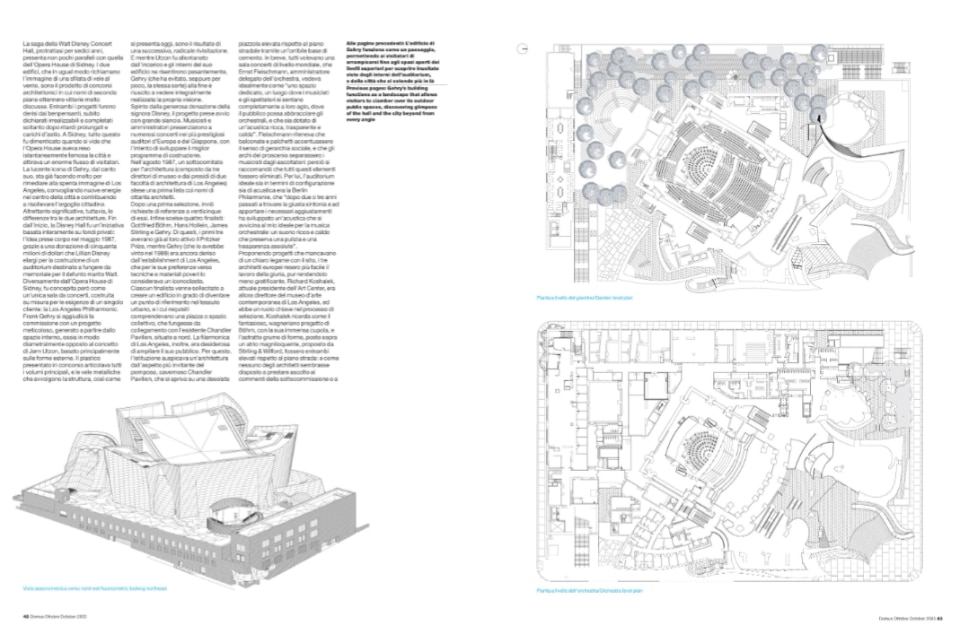
Utzon was dismissed and his interiors gravely compromised; Gehry barely escaped a similar fate, but was ultimately able to realize his entire vision. Buoyed by the generosity of Mrs. Disney’s gift, the project began with a burst of enthusiasm. Musicians and administrators attended performances at major concert halls in Europe and Japan to develop criteria for a building programme.
In August 1987, an architectural subcommittee comprising three museum directors and the deans of two L.A. architecture schools drew up a list of 80 architects, requested qualifications from 25 of them and then picked 4 finalists: Gottfried Böhm, Hans Hollein, James Stirling and Gehry. The first three had won the Pritzker Prize; Gehry would win his in 1989, but he was still derided by the L.A. establishment as an iconoclast who worked in rough-edged plywood and chain link, and an absurd choice for a major public commission.
Each finalist was challenged to create a civic monument with an inviting plaza that would relate to the Chandler Pavilion to the north. However, the Philharmonic wanted to broaden its audience and was seeking something friendlier than that pompous, cavernous hall, which opens onto a sterile plaza elevated above the street on a forbidding concrete podium. Everyone wanted a world-class concert hall. Ernest Fleischmann, the orchestra’s managing director, defined the goal as ‘a single-purpose hall, a space where musicians and concertgoers will feel totally at home, and the audience will embrace the performers, [with] acoustics that are rich, clear and warm’. He felt that balconies and boxes reinforced social hierarchy and that proscenium arches separated players from listeners, and he urged that these be eliminated. For him, the model hall – in its configuration and its sound – was the Berlin Philharmonie, which ‘after two or three years of fine-tuning and adjusting risers developed an acoustic that comes near to my ideal for orchestral music – rich, warm sound that preserves absolute clarity and transparency’.
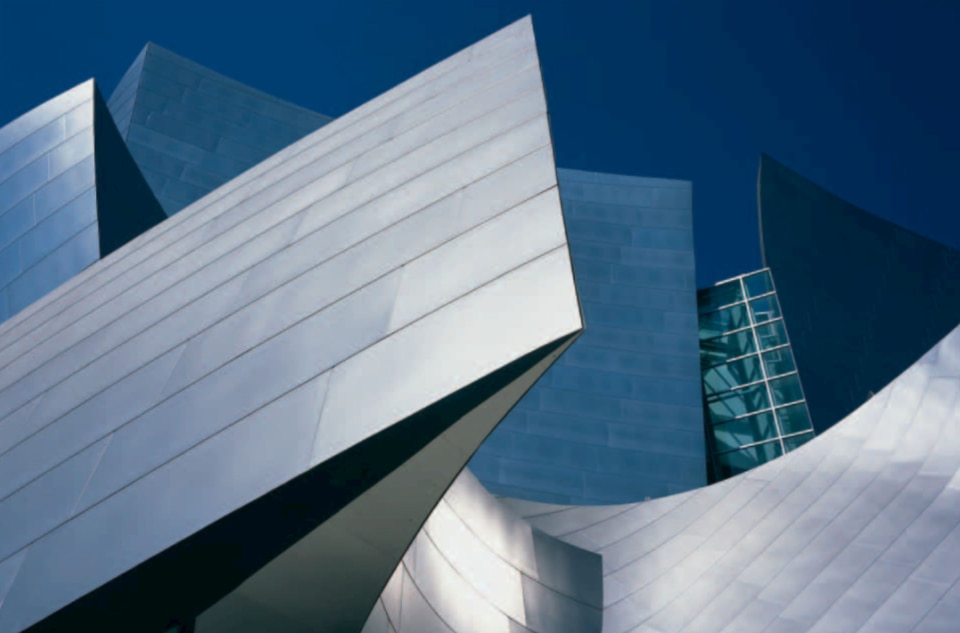
The trio of European architects made the jury’s job easier, though less rewarding, by submitting sub-par schemes that failed to engage the site. Richard Koshalek, now president of Art Center, was then director of L.A.’s Museum of Contemporary Art, and he played a key role in the selection process. He recalls that Böhm’s Wagnerian fantasy, with its immense dome, and Stirling & Wilford’s cluster of abstract forms atop a grand concourse were both raised above the street, and neither architect seemed willing to heed the subcommittee’s comments or modify his designs for the structure or the auditorium. Hollein presented four alternative schemes replete with pop images (including a Mickey Mouse bridge) and a mishmash of cladding materials.
Gehry was playing on home ground, having practiced in L.A. for 30 years, designed concert shells for classical music on both coasts and become a regular at Philharmonic concerts. He proposed an auditorium that resembled a flower, with tiers of seats radiating like petals from the stage – a steeply banked vineyard plan that was clearly inspired by the Berlin Philharmonie. His configuration generated a tiered exterior, set at an angle to the street, with an expansive glass atrium that the architect called ‘a living room for the city’. As he explained, ‘I’m trying to make a building that invites you in – the body language is welcoming’.
The rotation of the plan provided terraces for gardens – a priority for Mrs. Disney – and generated a diagonal axis that established a link to MOCA and a linear north-south axis extending through the Music Center. Gehry’s entire office worked on the plans and models over a period of several months, trying to resolve every issue, and the effort paid off. In December 1988 their scheme became the hands-down winner, and sceptics on the committee were soon won over.
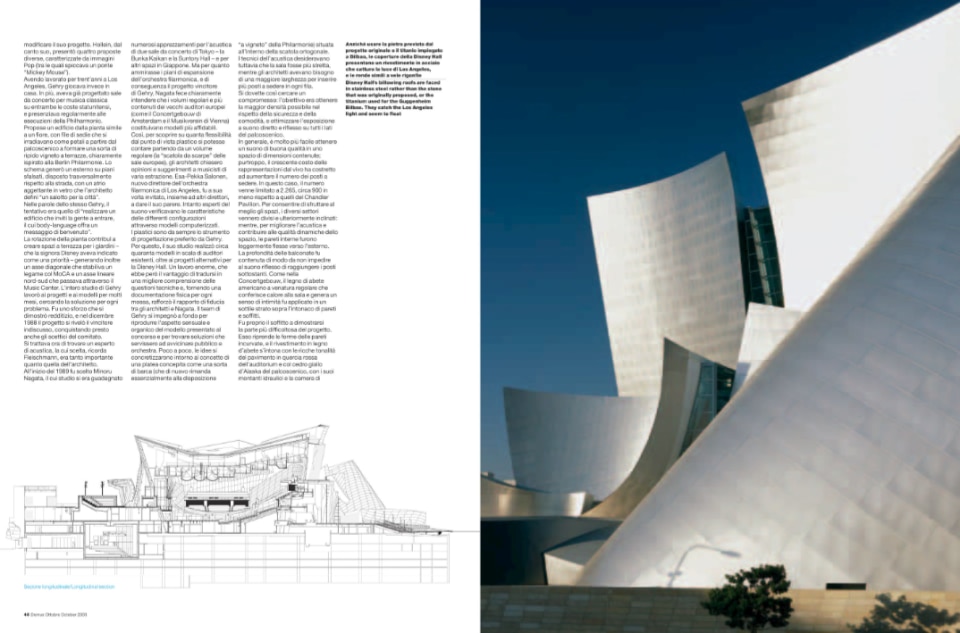
'The search for an acoustician was as important as the selection of an architect’, notes Fleischmann. The committee looked for someone with a proven track record and a willingness to work harmoniously with Gehry and not dictate the design. Early in 1989 they chose Dr. Minoru Nagata, whose firm had won acclaim for the acoustics of two Tokyo auditoriums – Bunka Kaikan and Suntory Hall – and other Japanese performance spaces. Much as he admired the expansive plan of the Philharmonie – and, by implication, the competition-winning design – Nagata insisted that the shoebox plan of older European halls, such as the Concertgebouw in Amsterdam and the Musikverein in Vienna, were better models.
To find out how much sculptural flexibility they had within the box, the architects sought comments and advice from a wide range of musicians. Models are Gehry’s preferred design tools on every job, and his team made approximately 40 scale models of existing auditoriums and alternative plans for Disney Hall, giving the office a better understanding of the technical issues and building trust between them and Nagata by providing a physical record of each move. Esa-Pekka Salonen, the newly appointed Philharmonic music director, and visiting conductors were invited to share their opinions, and the acousticians tested the different configurations by modelling them on a computer.
Gehry’s team struggled to recapture the organic, sensual feel of the competition model and to find ways of bringing the audience and orchestra closer together. Gradually, their ideas coalesced around the concept of the seating deck as a kind of barge – essentially the vineyard scheme of the Philharmonie – within the orthogonal box.
The cousticians wanted the hall to be narrower, while the architects needed greater width to put more seats in the tiers to either side, so they compromised. The goal was to achieve the greatest density that comfort and safety would allow and to maximize exposure to direct and reflected sound on all sides of the stage.
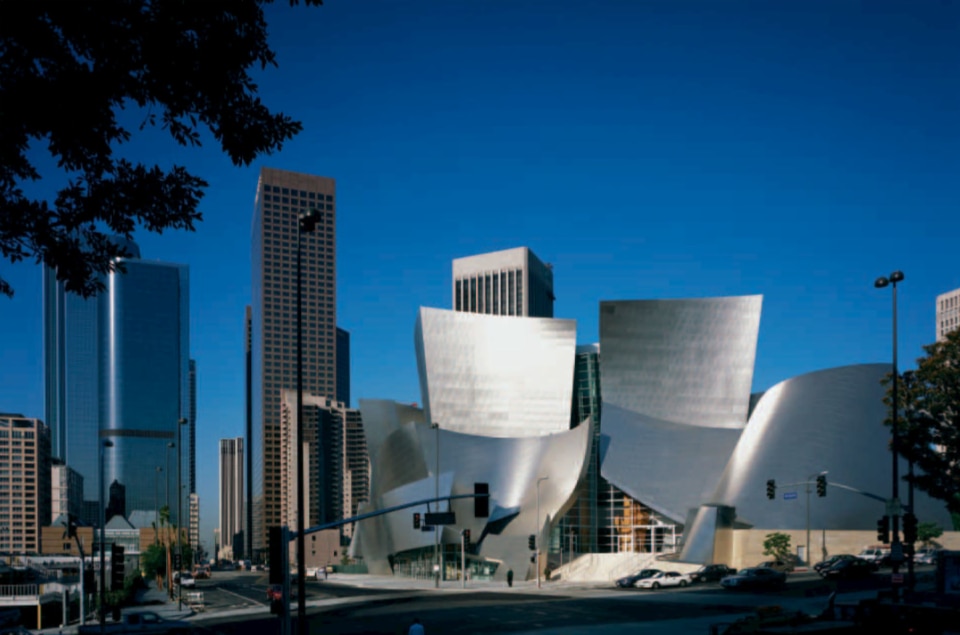
It is much easier to achieve good-quality sound in a small hall; unfortunately, the rising costs of live performance have pushed up the number of seats to levels that can defeat the best efforts of architects and acousticians. Here the number was held down to 2,265 – about 900 fewer than the Chandler Pavilion. The blocks of seating were steeply raked and broken up to provide intimate groupings, and the inner walls were tilted outward, improving the acoustics and contributing to the dynamic quality of the hall. The balconies were kept shallow so as not to block the seats below from reflected sound. The straight-grain Douglas fir that gives the hall its warmth and generates a feeling of intimacy is a thin layer over hard plaster walls and ceiling, as in the Concertgebouw.
The ceiling proved to be the most challenging part of the design. Bowed strips that evoke billowing sails (and the bent maple furniture that Gehry was creating for Knoll during this time) are precisely spaced and contoured to maximize sound reflection. The ceiling plays off the curved walls, and the fir complements the rich tones of the red-oak floor in the auditorium and the Alaskan yellow cedar of the stage area, with its hydraulic risers and resonating chamber below. Nagata determined that the upper corners of the auditorium were acoustically insignificant, and that encouraged the architects to split open their barge to reveal a 36-foot-tall window at the rear and a pair of skylights at each corner. Natural light defines the perimeter of the room and provides a visual link with the natural world during daytime rehearsals and matinee performances.
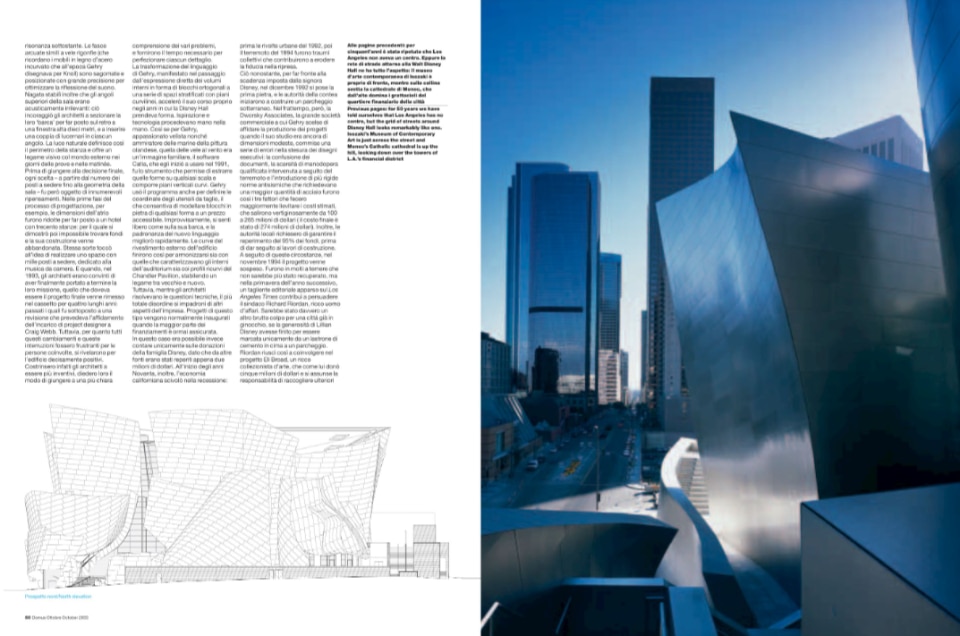
Every decision, from the number of seats to the geometry of the hall, went back and forth before it was resolved, and each change had a domino effect on all the other elements. At the outset of the design process, the lobby was scaled back to make room on the site for a 300-room hotel and ballroom, but these proved impossible to finance and were dropped, along with a 1,000-seat chamber-music hall.
The architects believed they had accomplished their mission in 1993, but that ‘final design’ was put on the shelf for four anguished years before being revised, with Craig Webb taking over as project designer. Frustrating as these shifts and interruptions were to all concerned, they enriched the building by compelling the architects to be more inventive, giving them a better understanding of the issues and providing abundant time to perfect every detail.
The transformation in Gehry’s language, from the direct expression of interior volumes as clustered orthogonal blocks to spaces layered with curvilinear planes, gathered momentum during the years Disney Hall was taking shape. Inspiration and technology went hand in hand. Billowing sails were familiar to Gehry as a weekend sailor and as an admirer of Dutch marine paintings. CATIA software, which he began using in 1991, allowed him to abstract those forms on any scale and to compose walls of curved planes, using the software to direct the cutting tools and make custom-shaped blocks of stone at an affordable price. Suddenly he felt as free as when he was in his boat, and his mastery of the new language grew rapidly. The curved wrappers echoed the billows in the auditorium and played off the bowed edges of the Chandler Pavilion, forging a link between new and old.
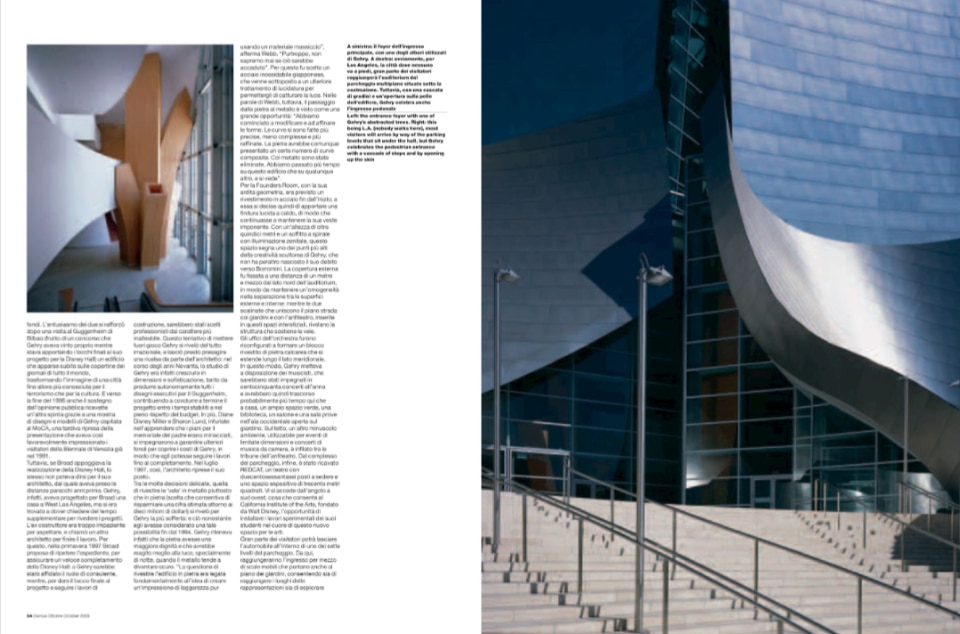
As the architects resolved the design issues, every other part of the venture fell into disarray. Projects of this kind are customarily unveiled when most of the funding has been promised. Disney Hall was secured only by donations from the Disney family; a mere $2 million was raised from other sources. The local economy slipped into recession in the early 1990s, and the urban riots of 1992 and the earthquake of 1994 traumatized the public and eroded business confidence.
Ground was broken in December 1992 to meet Mrs. Disney’s deadline, and county authorities began building the underground parking garage. Dworsky Associates, the large commercial firm that Gehry had selected to be executive architect when his own office was modestly sized, failed to produce useable working drawings. The confusion of the documents, a shortage of construction capacity following the earthquake and a tougher seismic code requiring more structural steel were three factors that drove up bids. The estimated cost of construction escalated from $100 million to $265 million (the final cost was $274 million), and the county advised the committee that they must have 95 per cent of their funding in place before construction of the hall could begin.
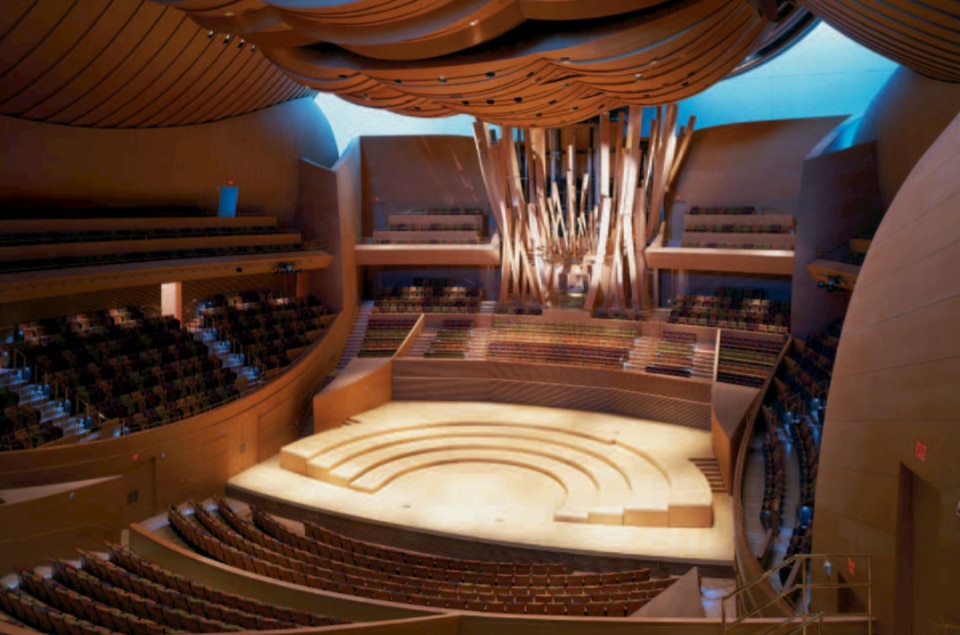
The project was shut down in November 1994, and many feared it might never resume. In the spring of 1995, a trenchant opinion piece in the Los Angeles Times (whose editors had offered only tepid support for the project up to that point) helped persuade Mayor Richard Riordan, a wealthy businessman, that it would be another blow for his battered city if Lillian Disney’s generosity was marked only by a concrete slab atop a parking garage. He brought in the billionaire art collector Eli Broad, and they each donated $5 million and took on responsibility for fund-raising. Their enthusiasm was reinforced by a visit to the Guggenheim Bilbao, the product of a competition that Gehry won just as he was putting the final touches on his design for Disney Hall. Soon that building would be featured on magazine covers around the world, transforming the image of a city better known for terrorism than culture. Public support was boosted in late 1996 by a free exhibition of models and drawings at MOCA – a belated reprise of the presentation that dazzled visitors at the 1991 Venice Biennale.
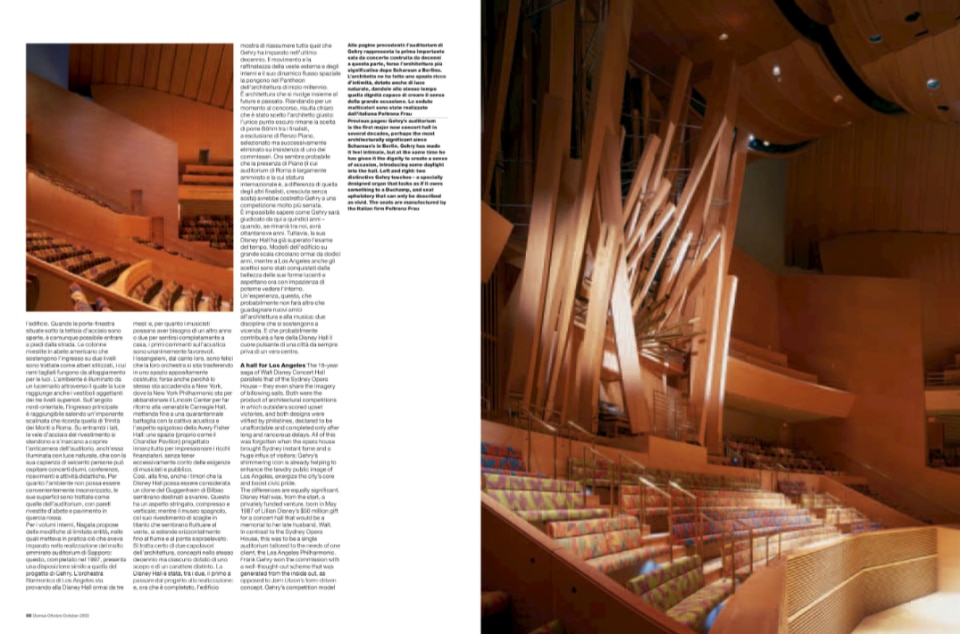
Broad backed Disney Hall but not its architect, with whom he had parted ways several years before. Gehry had designed a mansion in West L.A. for Broad and wanted additional time to refine the plans; the former tract-home builder was too impatient to wait, and he hired another architect to finish the job. In spring 1997, Broad proposed a similar expedient to ensure the swift completion of Disney Hall. Gehry would be relegated to the role of consultant, and more tractable architects would be chosen to round out the design and supervise construction. This attempt to sideline Gehry was as irrational as it was vindictive. His office had grown in size and sophistication through the mid-1990s. It did all of the construction drawings for the Guggenheim, and the project had come in on schedule and on budget. Diane Disney Miller and Sharon Lund, enraged to learn that the design of their father’s memorial might be compromised, pledged family funds to cover Gehry’s costs and guaranteed that he would see the job through to completion. His office resumed work in July 1997.
The decision to clad the sails in metal rather than stone to save an estimated $10 million was a difficult one for Gehry, though he had considered the possibility as early as 1994. He felt that stone would have greater dignity and take the light better, especially at night, when metal can turn black. ‘The trick with a stone building was to make a massive material feel ethereal’, says Webb. ‘We’ll never know if it would have done so’. They selected a lustrous Japanese stainless steel that was wire-brushed to pick up the light. Webb recalls the switch from stone as a great opportunity: ‘We started changing and refining the shapes. The curves are stronger, less complex and more refined. Stone would have had a limited number of compound curves; the steel has none. We spent longer on this than any other building, and it shows’.
The boldly articulated Founders Room had always been clad with steel; now it was given a bright, annealed finish so that it would continue to stand out. More than 50 feet high, the room’s scrolled and skylit plaster ceiling marks a high point of Gehry’s sculptural invention, though he is happy to acknowledge Borromini as a source of inspiration. The wrapper was pulled five feet away from the north side of the auditorium to make the separation of outer and inner surfaces consistent all around. The two flights of steps that lead from the street to the gardens and amphitheatre are threaded through these interstitial spaces and reveal the structural frame that supports the sails.
The orchestra’s offices were reconfigured as a limestone-clad block extending along the south front. Gehry gave the musicians, who will play 150 concerts a year and may spend more time here than they do at home, a spacious green room, a library, a lounge and rehearsal rooms in the west wing, opening onto the garden. A small recital hall is tucked in beneath the bleachers of the rooftop amphitheatre, which may be used for public recitals and chamber-music performances. REDCAT, a 266-seat black-box theatre and a 3,000-square-foot exhibition area are carved out of the parking garage and entered from the southwest corner, giving the California Institute of the Arts, which Walt Disney founded, an opportunity to showcase experimental work at the heart of L.A.’s new arts corridor.
Most visitors will leave their cars in the seven-level parking garage and take escalators to the lobby and up to the garden level to explore the building or attend a performance. A few may walk in from the street when the bi-fold windows beneath the steel canopy are open. Fir-clad columns supporting the two-level lobby are treated as stylized trees, with severed branches providing uplights. The space is lit from skylights high above, which also illuminate the projecting concourses on three upper levels. At the northeast corner, a grand staircase that owes something (including its travertine treads) to the Spanish Steps in Rome, leads up to the formal entrance. Steel wrappers billow out to either side and arch over the skylit pre-concert hall, which will accommodate up to 600 people for daytime music, pre-concert lectures, receptions and educational programmes. Although it cannot be soundproofed, its surfaces are treated like those of the auditorium, with a fir veneer over hard plaster walls and a red-oak floor.
Nagata proposed minor improvements to the auditorium, applying the lessons he learned from his much-admired Sapporo Concert Hall in Japan, which has a similar layout to Disney Hall and was completed in 1997. The Philharmonic has been rehearsing in Disney Hall for three months, and advance reports on the acoustics have been unanimously favourable, though the orchestra may need another year or two to feel entirely at home. Angelenos are delighted that their orchestra is moving to a purpose-built hall, just as the New York Philharmonic is about to abandon its 40-year struggle with the bad acoustics and sightlines at Lincoln Center’s Avery Fisher Hall to return to the venerable Carnegie Hall. Fisher was designed, like the Chandler Pavilion, primarily to impress affluent patrons, short-changing the musicians and the rest of the audience.
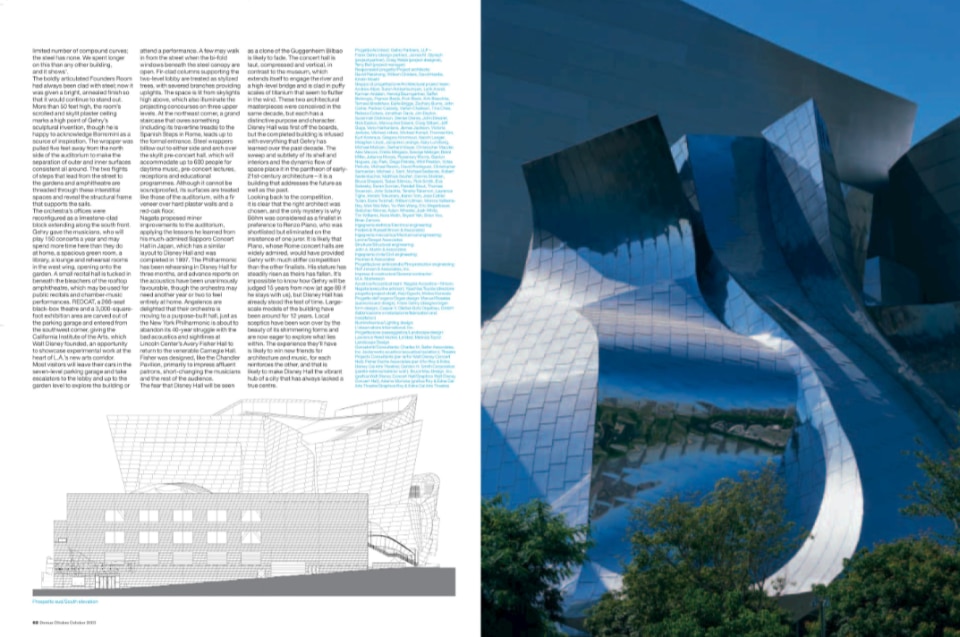
The fear that Disney Hall will be seen as a clone of the Guggenheim Bilbao is likely to fade. The concert hall is taut, compressed and vertical, in contrast to the museum, which extends itself to engage the river and a high-level bridge and is clad in puffy scales of titanium that seem to flutter in the wind. These two architectural masterpieces were conceived in the same decade, but each has a distinctive purpose and character. Disney Hall was first off the boards, but the completed building is infused with everything that Gehry has learned over the past decade. The sweep and subtlety of its shell and interiors and the dynamic flow of space place it in the pantheon of early-21st-century architecture – it is a building that addresses the future as well as the past.
Looking back to the competition, it is clear that the right architect was chosen, and the only mystery is why Böhm was considered as a finalist in preference to Renzo Piano, who was shortlisted but eliminated on the insistence of one juror. It is likely that Piano, whose Rome concert halls are widely admired, would have provided Gehry with much stiffer competition than the other finalists. His stature has steadily risen as theirs has fallen. It’s impossible to know how Gehry will be judged 15 years from now (at age 89 if he stays with us), but Disney Hall has already stood the test of time. Large-scale models of the building have been around for 12 years. Local sceptics have been won over by the beauty of its shimmering forms and are now eager to explore what lies within. The experience they’ll have is likely to win new friends for architecture and music, for each reinforces the other, and that is likely to make Disney Hall the vibrant hub of a city that has always lacked a true centre.

